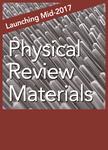版权所有:内蒙古大学图书馆 技术提供:维普资讯• 智图
内蒙古自治区呼和浩特市赛罕区大学西街235号 邮编: 010021

作者机构:Key Laboratory of Materials Modification by Laser Electron and Ion Beams (Dalian University of Technology) Ministry of Education Dalian 116024 China Applied Materials Physics Department of Materials Science and Engineering KTH-Royal Institute of Technology Stockholm SE-10044 Sweden Department of Physics and Astronomy Division of Materials Theory Uppsala University Box 516 SE-75120 Uppsala Sweden Research Institute for Solid State Physics and Optics Wigner Research Center for Physics Budapest H-1525 P.O. Box 49 Hungary
出 版 物:《Physical Review Materials》 (Physic. Rev. Mat.)
年 卷 期:2019年第3卷第3期
页 面:034401-034401页
核心收录:
基 金:Swedish Foundation for International Cooperation in Research and Higher Education, STINT Stiftelsen för Strategisk Forskning, SSF Hungarian Scientific Research Fund, OTKA, (OTKA 128229) Vetenskapsrådet, VR China Scholarship Council, CSC National Magnetic Confinement Fusion Program of China, (2015GB118001)
主 题:Density of states Ferrimagnetism Ferromagnetism Surface & interfacial phenomena Body-centered cubic Disordered alloys Transition metal alloys Density functional calculations Korringa-Kohn-Rostoker method
摘 要:A density-functional theory investigation of the (100) and (110) surfaces of the body-centered cubic (bcc) Fe1−xbCrxb binary alloys, xb≤15 at.%, is reported. The energies and segregation energies of these surfaces were calculated for chemically homogeneous concentration profiles and for Cr surface contents deviating from the nominal one of the bulk. The implications of these results for the surface alloy phase diagram are discussed. The surface chemistry of Fe−Cr(100) is characterized by a transition from Cr depletion to Cr enrichment in a critical bulk Cr composition window of 6xb9 at.%. In contrast, such threshold behavior of the surface Cr content is absent for Fe−Cr(110) and a nearly homogeneous Cr concentration profile is energetically favorable. The strongly suppressed surface-layer relaxation at both surfaces is shown to be of magnetic origin. The compressive, magnetic contribution to the surface relaxation stress is found to correlate well with the surface magnetic moment squared at both surface terminations. The stability of the Cr surface magnetic moments against bulk Cr content is clarified based on the surface electronic structure.